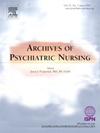Keeping crisis from becoming an emergency: Predictors of ED diversion in police-led behavioral health responses
IF 2.2
4区 医学
Q1 NURSING
引用次数: 0
Abstract
As law enforcement increasingly responds to behavioral health crises, both jail and Emergency Department (ED) diversion are essential considerations, as ED utilization for these cases often leads to extended boarding times and repeat visits, straining healthcare resources. Despite growing implementation of police-led jail diversion programs, a significant gap remains in understanding the specific factors that influence ED diversion outcomes, particularly for behavioral health crisis incidents. To identify predictors of ED diversion, we analyzed 10,904 behavioral health crisis incident records from the Massachusetts Department of Mental Health's Jail Diversion Program database (May–December 2023) using logistic regression and hybrid machine learning techniques. Co-response clinicians achieved the highest diversion rates, followed by CIT-trained officers, while evening/overnight incidents and police referrals were less likely to result in diversion. Community-based assessments showed modest improvements in diversion likelihood. Demographic predictor variables significantly influenced outcomes, while severe psychiatric concerns and substance use decreased diversion probability. These findings highlight the contribution of jail diversion programs, particularly through co-response clinicians, and suggest the need for expanded community mental health resources, particularly during off-hours. Results underscore how psychiatric acuity, substance use, and response team composition influence diversion outcomes, with implications for enhancing mental health nursing practice in crisis response systems.
防止危机变成紧急情况:警察主导的行为健康反应中ED转移的预测因素
随着执法部门对行为健康危机的反应越来越多,监狱和急诊科(ED)的转移是必不可少的考虑因素,因为使用急诊科处理这些案件通常会导致延长登机时间和重复就诊,从而使医疗资源紧张。尽管越来越多的实施警察主导的监狱转移计划,但在理解影响ED转移结果的具体因素方面仍然存在重大差距,特别是对于行为健康危机事件。为了确定ED转移的预测因素,我们使用逻辑回归和混合机器学习技术分析了马萨诸塞州精神卫生部门监狱转移项目数据库(2023年5月至12月)中的10,904个行为健康危机事件记录。共同反应临床医生的转诊率最高,其次是cit培训的官员,而夜间/夜间事件和警察转诊的可能性较小。基于社区的评估显示,转移的可能性略有改善。人口统计学预测变量显著影响结果,而严重的精神问题和物质使用降低了转移的可能性。这些发现突出了监狱转移计划的贡献,特别是通过共同反应临床医生,并建议需要扩大社区精神卫生资源,特别是在非工作时间。结果强调了精神敏锐度、物质使用和反应小组组成如何影响转移结果,这对加强危机反应系统中的心理健康护理实践具有重要意义。
本文章由计算机程序翻译,如有差异,请以英文原文为准。
求助全文
约1分钟内获得全文
求助全文
来源期刊
CiteScore
3.70
自引率
0.00%
发文量
131
审稿时长
160 days
期刊介绍:
Archives of Psychiatric Nursing disseminates original, peer-reviewed research that is of interest to psychiatric and mental health care nurses. The field is considered in its broadest perspective, including theory, practice and research applications related to all ages, special populations, settings, and interdisciplinary collaborations in both the public and private sectors. Through critical study, expositions, and review of practice, Archives of Psychiatric Nursing is a medium for clinical scholarship to provide theoretical linkages among diverse areas of practice.

 求助内容:
求助内容: 应助结果提醒方式:
应助结果提醒方式:


